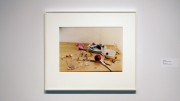This past November, Winnipeg hosted Send+Receive, a festival celebrating artists who work exclusively with sound. While I enjoyed many performances during the festival, it left me with questions: What exactly is sound art? Is it a useful, or even valid term? The John Cage compositions that premiered on UMFM just recently brought these back to the front of my mind.
At its most basic, one could say it’s any art based around sound, but more specifically, “sound artists” seem to be preoccupied with creating a sonic tapestry while avoiding melody and structure. Why though, are these artists distinct from any musician? The most common answer I’ve received is that sound art is not musical, but this definition raises some real issues.
While a sound artist might layer static and echoes while avoiding identifiable notes, what is a beat if not (any) repeated sound? What is a melody if not the sounds played over that basic rhythm? The presence of harmony and structure cannot be the only qualifiers for what makes music, unless we’re willing to tell anyone who plays ambient, atonal, or free jazz pieces that it turns out they aren’t musicians after all.
To make this line drawn between sound artists and musicians even more tenuous, consider artists who have worked outside those boundaries since long before sound art became a popular term. John Cage’s most famous work is 4’33”, four minutes and 30 seconds of silence, and he has compositions that involve amplifying a room, then executing a non-musical action in it. The Japanese artists Masonna and Merzbow both layer static, harsh electronic noise and screams to create their songs. All three of these individuals create works that are far more conceptual and less recognizably musical than any of the “sound artists” I saw at Send+Receive.
While people certainly try to marginalize these artists by saying their compositions aren’t music, they’re self-professed musicians and anyone who chooses to take them seriously refers to them as such. In fact, Merzbow is playing a concert in May with Venetian Snares here in Winnipeg. They’ll be at the Albert by the way, not the Art Barn.
Why then are these musicians who play concerts at venues distinct from sound artists who have performances in art galleries? The only answer is that it’s a matter of choice. Sound artists choose to exist within the art world, maybe because it’s the environment with which they’re comfortable, or maybe because they fear being rejected as musicians. While this is obviously their choice to make, it isn’t without repercussions.
As a musician who enjoys experimentation, breaking down sound-based art that is music versus sound-based art that is not music worries me. If this distinction exists, what’s to stop anyone from declaring that my music is too experimental, revealing that in fact it’s not music at all, it’s sound art? I would prefer not to be relegated to performing only in gallery spaces. Setting limits on what is acceptable experimentation within a medium is harmful to it; it strangles free expression. In any case, some precision of terms is necessary. When one makes art with paint, it’s called painting. When one makes art with sound, the word for it is music.


